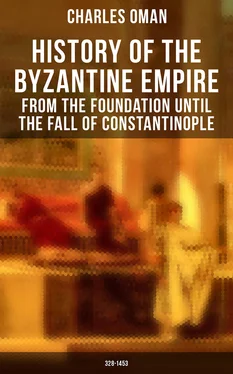Pressed against the Danube and the Roman border, the Visigoths sent in despair to ask permission to cross from the Emperor. A contemporary writer describes how they stood. “All the multitude that had escaped from the murderous savagery of the Huns—no less than 200,000 fighting men, besides women and old men and children—-were there on the river bank, stretching out their hands with loud lamentations, and earnestly supplicating leave to cross, bewailing their calamity, and promising that they would ever faithfully adhere to the imperial alliance if only the boon was granted them.”
At this moment (a.d. 376) the Roman Empire was again divided. The house of Constantine was gone, and the East was ruled by Valens, a stupid, cowardly, and avaricious prince, who had obtained the diadem and half the Roman world only because he was the brother of Valentinian, the greatest general of the day. Valentinian had taken the West for his portion, and dwelt in his camp on the Rhine and Upper Danube, while Valens, slothful and timid, shut himself up with a court of slaves and flatterers in the imperial palace at Constantinople.
The proposal of the Goths filled Valens with dismay. It was difficult to say which was more dangerous—to refuse a passage to 200,000 desperate men with arms in their hands and a savage foe at their backs, or to admit them within the line of river and fortress that protected the border, with an implied obligation to find land for them. After much doubting he chose the latter alternative: if the Goths would give hostages and surrender their arms, they should be ferried across the Danube and permitted to settle as subject-allies within the empire.
The Goths accepted the terms, gave up the sons of their chiefs as hostages, and streamed across the river as fast as the Roman Danube-flotilla could transport them. But no sooner had they reached Moesia than troubles broke out. The Roman officials at first tried to disarm the immigrants, but the Goths were unwilling to surrender their weapons, and offered large bribes to be allowed to retain them: in strict disobedience to the Emperor's orders, the bribes were accepted and the Goths retained their arms. Further disputes soon broke out. The provisions of Moesia did not suffice for so many hundred thousand mouths as had just entered its border, and Valens had ordered stores of corn from Asia to be collected for the use of the Goths, till they should have received and commenced to cultivate land of their own. But the governor, Lupicinus, to fill his own pockets, held back the food, and doled out what he chose to give at exorbitant prices. In sheer hunger the Goths were driven to barter a slave for a single loaf of bread and ten pounds of silver for a sheep. This shameless extortion continued as long as the stores and the patience of the Goths lasted. At last the poorer immigrants were actually beginning to sell their own children for slaves rather than let them starve. This drove the Goths to desperation, and a chance affray set the whole nation in a blaze. Fritigern, with many of his nobles, was dining with Count Lupicinus at the town of Marcianopolis, when some starving Goths tried to pillage the market by force. A party of Roman soldiers strove to drive them off, and were at once mishandled or slain. On hearing the tumult and learning its cause, Lupicinus recklessly bade his retinue seize and slay Fritigern and the other guests at his banquet. The Goths drew their swords and cut their way out of the palace. Then riding to the nearest camp of his followers, Fritigern told his tale, and bade them take up arms against Rome.
There followed a year of desperate fighting all along the Danube, and the northern slope of the Balkans. The Goths half-starved for many months, and smarting under the extortion and chicanery to which they had been subjected, soon showed that the old barbarian spirit was but thinly covered by the veneer of Christianity and civilization which they had acquired in the last half-century. The struggle resolved itself into a repetition of the great raids of the third century: towns were sacked and the open country harried in the old style, nor was the war rendered less fierce by the fact that many runaway slaves and other outcasts among the provincial population joined the invaders. But the Roman armies still retained their old reputation; the ravages of the Goths were checked at the Balkans, and though joined by the remnants of the Ostrogoths from the Danube mouth, as well as by other tribes flying from the Huns, the Visigoths were at first held at bay by the imperial armies. A desperate pitched battle at Ad Salices, near the modern Kustendje thinned the ranks of both sides, but led to no decisive result.
Next year, however, the unwarlike Emperor, driven into the field by the clamours of his subjects, took the field in person, with great reinforcements brought from Asia Minor. At the same time his nephew Gratian, a gallant young prince who had succeeded to the Empire of the West, set forth through Pannonia to bring aid to the lands of the Lower Danube.
The personal intervention of Valens in the struggle was followed by a fearful disaster. In 378 a.d., the main body of the Goths succeeded in forcing the line of the Balkans; they were not far from Adrianople when the Emperor started to attack them, with a splendid army of 60,000 men. Every one expected to hear of a victory, for the reputation of invincibility still clung to the legions, and after six hundred years of war the disciplined infantry of Rome, robur peditum , whose day had lasted since the Punic wars, were still reckoned superior, when fairly handled, to any amount of wild barbarians.
But a new chapter of the history of the art of war was just commencing; during their sojourn in the plains of South Russia and Roumania the Goths had taken, first of all German races, to fighting on horseback. Dwelling in the Ukraine they had felt the influence of that land, ever the nurse of cavalry from the day of the Scythian to that of the Tartar and Cossack. They had come to “consider it more honourable to fight on horse than on foot,” and every chief was followed by his war-band of mounted men. Driven against their will into conflict with the empire, they found themselves face to face into the army that had so long held the world in fear, and had turned back their own ancestors in rout three generations before.
Valens found the main body of the Goths encamped in a great “laager,” on the plain north of Adrianople. After some abortive negotiations he developed an attack on their front, when suddenly a great body of horsemen charged in on the Roman flank. It was the main strength of the Gothic cavalry, which had been foraging at a distance; receiving news of the fight it had ridden straight for the battle field. Some Roman squadrons which covered the left flank of the Emperor's army were ridden down and trampled under foot. Then the Goths swept down on the infantry of the left wing, rolled it up, and drove it in upon the centre. So tremendous was their impact that legions and cohorts were pushed together in hopeless confusion. Every attempt to stand firm failed, and in a few minutes left, centre, and reserve, were one undistinguishable mass. Imperial guards, light troops, lancers, auxiliaries, and infantry of the line were wedged together in a press that grew closer every moment. The Roman cavalry saw that the day was lost, and rode off without another effort. Then the abandoned infantry realized the horror of their position: equally unable to deploy or to fly, they had to stand to be cut down. Men could not raise their arms to strike a blow, so closely were they packed; spears snapped right and left, their bearers being unable to lift them to a vertical position; many soldiers were stifled in the press. Into this quivering mass the Goths rode, plying lance and sword against the helpless enemy. It was not till forty thousand men had fallen that the thinning of the ranks enabled the survivors to break out and follow their cavalry in a headlong flight. They left behind them, dead on the field, the Emperor, the Grand Masters of the Infantry and Cavalry, the Count of the Palace, and thirty-five commanders of different corps.
Читать дальше












